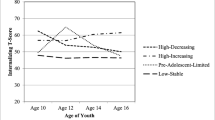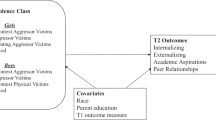Abstract
Previous analyses of data from the 4-H Study of Positive Youth Development (PYD) have examined concurrent trajectories of positive development and risk/problem behaviors among adolescents, finding complex and not necessarily inverse relationships among them. In this article, we expand on prior research by employing a person-centered approach to modeling risk behaviors, assessing development from approximately 6th grade through 12th grade among 4,391 adolescents (59.9 % female). Latent profiles involving the problematic behaviors of delinquency, depressive symptoms, substance use, sexual activity, disordered eating behaviors, and bullying were then assessed for concurrent relationships with the Five Cs of PYD: Competence, Confidence, Character, Caring, and Connection. We found six latent profiles, based primarily on mental health, aggression, and alcohol use, with significant differences in Confidence levels among many of the profiles, as well as some differences in the four other Cs. We discuss directions for future research and implications for application to youth policies and programs.










Similar content being viewed by others
References
Allen, J. P., Porter, M. R., Mcfarland, F. C., Marsh, P., & Mcelhaney, K. B. (2005). The two faces of adolescents’ success with peers: Adolescent popularity, social adaptation, and deviant behavior. Child Development, 76(3), 747–760.
Asparouhov, T., & Muthén, B. O. (2013). Auxiliary variables in mixture modeling: A 3-step approach using Mplus. Mplus Web Notes, 15, 1–48.
Benson, P. L., Mannes, M., Pittman, K., & Ferber, T. (2004). Youth development, developmental assets and public policy. In R. M. Lerner & L. Steinberg (Eds.), Handbook of adolescent psychology (2nd ed., pp. 781–814). New York, NY: Wiley.
Collins, L. M., & Lanza, S. T. (2010). Latent class and latent transition analysis: With applications in the social, behavioral, and health sciences. New York, NY: Wiley.
Crockett, L. J., Raffaelli, M., & Shen, Y. L. (2006). Linking self-regulation and risk proneness to risky sexual behavior: Pathways through peer pressure and early substance use. Journal of Research on Adolescence, 16(4), 503–525.
Diamond, L. M., & Savin-Williams, R. C. (2009). Adolescent sexuality. In L. Steinberg & R. M. Lerner (Eds.), Handbook of adolescent psychology (3rd ed., pp. 479–523). New York: Wiley.
Diego, M. A., Field, T. M., & Sanders, C. E. (2003). Academic performance, popularity, and depression predict adolescent substance abuse. Adolescence, 38, 35–42.
Dworkin, J. (2005). Risk taking as developmentally appropriate experimentation for college students. Journal of Adolescent Research, 20(2), 219–241.
Fay, K., & Lerner, R. M. (2013). Weighing in on the issue: A longitudinal analysis of the influence of selected individual factors and the sports context on the developmental trajectories of eating pathology among adolescents. Journal of Youth and Adolescence, 42(1), 33–51.
Garner, D. M., Olmstead, M. P., & Polivy, J. (1983). Development and validation of a multidimensional eating disorder inventory for anorexia nervosa and bulimina. International Journal of Eating Disorder, 2, 15–34.
Geldhof, G. J., Bowers, E. P., Mueller, M. K., Napolitano, C. M., Schmid, K. L., & Lerner, R. M. (2014). Longitudinal analysis of a very short measure of positive youth development. Journal of Youth and Adolescence. doi:10.1007/s10964-014-0093-z.
Hamilton, S. F. (1999). A three-part definition of positive youth development. Unpublished manuscript. Ithaca, NY: Cornell University.
Johnston, L. D., O’Malley, P. M., & Bachman, J. G. (2001). Monitoring the future national survey results on drug use, 1975–2000. Volume I: Secondary school students. Bethesda, MD: National Institute on Drug Abuse.
Jung, T., & Wickrama, K. A. (2008). An introduction to latent class growth analysis and growth mixture modeling. Social and Personality Psychology Compass, 2, 302–317.
Lanza, S. T., Rhoades, B. L., Nix, R. L., & Greenberg, M. T. (2010). Modeling the interplay of multilevel risk factors for future academic and behavior problems: A person-centered approach. Development and Psychopathology, 22(2), 313–335.
Leffert, N., Benson, P. L., Scales, P. C., Sharma, A. R., Drake, D. R., Dale, A., et al. (1998). Developmental assets: Measurement and prediction of risk behaviors among adolescents developmental assets. Applied Developmental Science, 2(4), 37–41.
Lerner, R. M. (1984). On the nature of human plasticity. Cambridge: Cambridge University Press.
Lerner, R. M. (2005). Promoting positive youth development: Theoretical and empirical bases. White paper prepared for the Workshop on the Science of Adolescent Health and Development, National Research Council/Institute of Medicine. Washington, D.C.: National Academies of Science.
Lerner, R. M. (2011). Structure and process in relational, developmental systems theories: A commentary on contemporary changes in the understanding of developmental change across the life span. Human Development, 54(1), 34–43.
Lerner, J. V., Bowers, E. P., Minor, K., Lewin-Bizan, S., Boyd, M. J., Mueller, M. K. et al. (2013). Positive youth development: Processes, philosophies, and programs. In R. M. Lerner, M. A., Easterbrooks, & J. Mistry (Eds.), Handbook of psychology, Volume 6: Developmental psychology (2nd ed.). Editor-in-chief: I. B. Weiner. (pp. 365–392). Hoboken, NJ: Wiley.
Lerner, J. V., Phelps, E., Forman, Y., & Bowers, E. P. (2009a). Positive youth development. In R. M. Lerner & L. Steinberg (Eds.), Handbook of adolescent psychology (3rd ed., Vol. 1, pp. 524–558). New York: Wiley.
Lerner, R. M., von Eye, A., Lerner, J. V., & Lewin-Bizan, S. (2009b). Exploring the foundations and functions of adolescent thriving within the 4-H Study of Positive Youth Development: A view of the issues. Journal of Applied Developmental Psychology, 30(5), 567–570.
Lerner, R. M., von Eye, A., Lerner, J. V., Lewin-Bizan, S., & Bowers, E. P. (2010). Special issue introduction: The meaning and measurement of thriving: A view of the issues. Journal of Youth and Adolescence, 39(7), 707–719.
Lewin-Bizan, S., Lynch, A. D., Fay, K. E., Schmid, K. L., McPherran, C., Lerner, J. V., et al. (2010). Trajectories of positive and negative behaviors from early- to middle-adolescence. Journal of Youth and Adolescence, 39(7), 751–763. doi:10.1007/s10964-010-9532-7.
Lo, B. Y., Mendell, N. R., & Rubin, D. B. (2001). Testing the number of components in a normal mixture. Biometrika, 88(3), 767–778.
Mayeux, L., Sandstrom, M. J., & Cillessen, A. H. N. (2008). Is being popular a risky proposition? Journal of Research on Adolescence, 18(1), 49–74.
Mays, D., Depadilla, L., Thompson, N. J., Kushner, H. I., & Windle, M. (2010). Sports participation and problem alcohol use: A multi-wave national sample of adolescents. American Journal of Preventive Medicine, 38(5), 491–498.
McCoy, T. P., Ip, E. H., Blocker, J. N., Champion, H., Rhodes, S. D., Wagoner, K. G., et al. (2009). Attrition bias in a U.S. internet survey of alcohol use among college freshmen. Journal of Studies on Alcohol and Drugs, 70(4), 606–614.
McLachlan, G. L., & Peel, D. (2000). Finite mixture models. New York, NY: Wiley.
Molenaar, P. C. M., & Nesselroade, J. R. (2009). The recoverability of P-technique factor analysis. Multivariate Behavioral Research, 44(1), 130–141.
Muthén, B. O., & Muthén, L. K. (2000). The development of heavy drinking from age 18-37 in a U.S. national sample. Journal of Studies on Alcohol, 61, 290–300.
Nesselroade, J. R., & Ford, D. H. (1985). P-technique comes of age: Multivariate, replicated, single-subject designs for research on older adults. Research on Aging, 7(1), 46–80.
Nylund, K. L., Asparouhov, T., & Muthén, B. O. (2007). Deciding on the number of classes in latent class analysis and growth mixture modeling: A Monte Carlo simulation study. Structural Equation Modeling: A Multidisciplinary Journal, 14(4), 535–569.
Olweus, D. (1996). The revised Olweus Bully/Victim Questionnaire. Bergen: Mimeo, Research Center for Health Promotion (HEMIL), University of Bergen.
Orth, U., Robins, R. W., & Roberts, B. W. (2008). Low self-esteem prospectively predicts depression in adolescence and young adulthood. Journal of Personality and Social Psychology, 95, 695–708.
Overton, W. F. (2013). Relationism and relational developmental systems: A paradigm for developmental science in the post-Cartesian era. In R. M. Lerner & P. L. Benson (Eds.), Advances in Child Development and Behavior, 44, 21–64.
Phelps, E., Balsano, A. B., Fay, K. E., Peltz, J. S., Zimmerman, S. M., Lerner, R. M., et al. (2007). Nuances in early adolescent developmental trajectories of positive and problematic/risk behaviors: Findings from the 4-H study of positive youth development. Child and Adolescent Psychiatric Clinics of North America, 16(2), 473–496.
Pittman, K., Irby, M., & Ferber, T. (2001). Unfinished business: Further reflections on a decade of promoting youth development. Trends in youth development: Visions, realities and challenges, 6, 4–50.
Post, A., Gilljam, H., Bremberg, S., & Galanti, M. R. (2012). Psychosocial determinants of attrition in a longitudinal study of tobacco use in youth. The Scientific World Journal, 2012, 654030. doi:10.1100/2012/654030
Radloff, L. S. (1977). The CES-D Scale: A self-report depression scale for research in the general population. Applied Psychological Measurement, 1(3), 385–401.
Rubin, K.H., Bukowski, W., & Parker, J. G. (1998). Peer interactions, relationships, and groups. In Handbook of Child Psychology (5th ed.), Volume 3: Social, emotional, and personality development. (pp. 619–700). New York, NY: Wiley.
Schaie, K. W., & Strother, C. R. (1968). The effect of time and cohort differences on the interpretation of age changes in cognitive behavior. Multivariate Behavioral Research, 3(3), 259–293.
Schulenberg, J. E. (2006). Understanding the multiple contexts of adolescent risky behavior and positive development: Advances and future directions. Applied Developmental Science, 10(2), 107–113.
Schulenberg, J. E., & Maggs, J. L. (2002). A Developmental perspective on alcohol use and heavy drinking during adolescence and the transition to young adulthood. Journal of Studies on Alcohol. Supplement, 14, 54–70.
Schwartz, S. J., Phelps, E., Lerner, J. V., Huang, S., Brown, C. H., Lewin-Bizan, S., et al. (2010). Promotion as prevention: Positive youth development as protective against tobacco, alcohol, illicit drug, and sex initiation. Applied Developmental Science, 14(4), 197–211.
Schwarz, G. (1978). Estimating the dimension of a model. The Annals of Statistics, 6(2), 461–464.
Solberg, M. E., & Olweus, D. (2003). Prevalence estimation of school bullying with the Olweus Bully/Victim Questionnaire. Aggressive Behavior, 29, 239–268.
Tucker, J. S., Ellickson, P. L., Orlando, M., Martino, S. C., & Klein, D. J. (2005). Substance use trajectories from early adolescence to emerging adulthood: A comparison of smoking, binge drinking, and marijuana use. Journal of Drug Issues, 35(2), 307–332.
Wiesner, M., & Windle, M. (2004). Assessing covariates of adolescent delinquency trajectories: A latent growth mixture modeling approach. Journal of Youth and Adolescence, 33(5), 431–442.
Zand, D., Thomson, N. R., Dugan, M., Braun, J. A., Holterman-Hommes, P., & Hunter, P. L. (2006). Predictors of retention in an alcohol, tobacco, and other drug prevention study. Evaluation Review, 30(2), 209–222.
Zarrett, N., Fay, K. E., Li, Y., Carrano, J., Phelps, E., & Lerner, R. M. (2009). More than child’s play: Variable- and pattern-centered approaches for examining effects of sports participation on youth development. Developmental Psychology, 45(2), 368–382.
Zimmerman, S. M., Phelps, E., & Lerner, R. M. (2008). Positive and negative developmental trajectories in U.S. adolescents: Where the positive youth development perspective meets the deficit model. Research in Human Development, 5(3), 153–165.
Acknowledgments
This research was supported in part by grants from the National 4-H Council, the Altria Corporation, the Thrive Foundation for Youth, and the John Templeton Foundation.
Author contributions
MA conceived of the study, participated in its design and the statistical analysis, supervised the literature review, drafted the manuscript, and coordinated the process; SK conceived of the study, participated in its design, planned the statistical analyses, and lead the analytic process; RC participated in the design of the study, helped with the tables, and conducted the literature review; KG participated in the design of the study, prepared the dataset, and conducted the descriptive statistical analyses; JL is the Scientific Director on the project, participated in the design of the study, and provided feedback on the manuscript drafts; RL is the Principal Investigator on the project, and provided feedback on the manuscript drafts. All authors read and approved the final manuscript.
Author information
Authors and Affiliations
Corresponding author
Rights and permissions
About this article
Cite this article
Arbeit, M.R., Johnson, S.K., Champine, R.B. et al. Profiles of Problematic Behaviors Across Adolescence: Covariations with Indicators of Positive Youth Development. J Youth Adolescence 43, 971–990 (2014). https://doi.org/10.1007/s10964-014-0092-0
Received:
Accepted:
Published:
Issue Date:
DOI: https://doi.org/10.1007/s10964-014-0092-0




